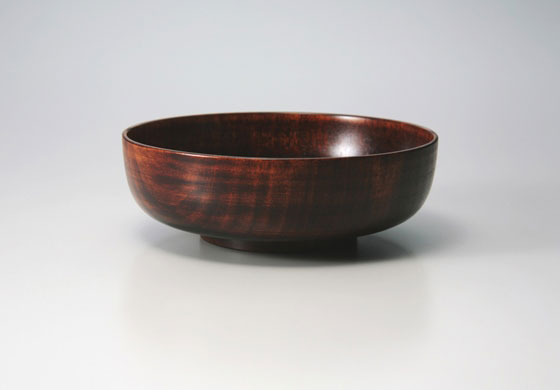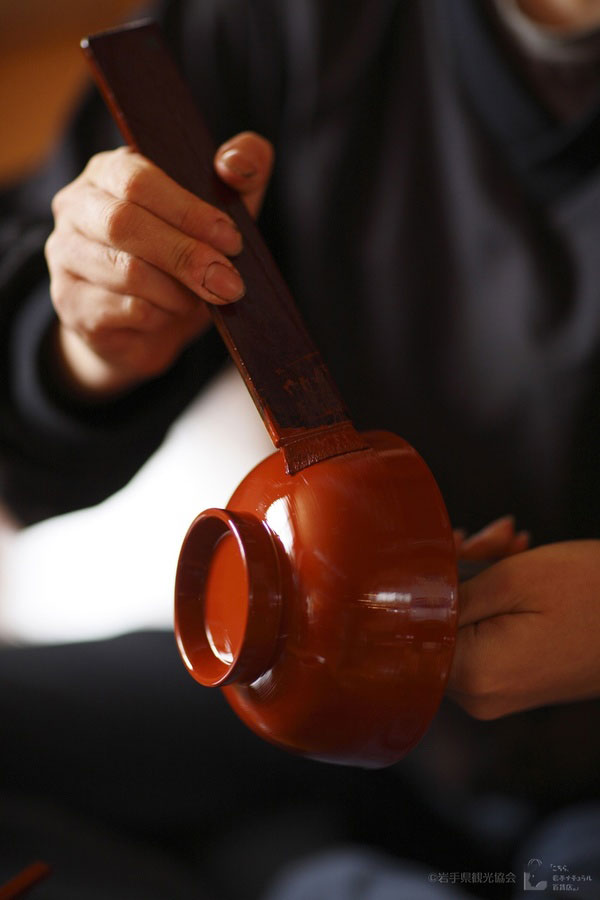
- Lacquerware
- Iwate
Joboji lacquerware Joboji nuri
Flowing from trees to lacquerware
Polished to a beautiful luster with time and use
Description
What is Joboji lacquerware ?
Joboji lacquerware (called Joboji nuri in Japanese) is produced in the town of Joboji in Iwate prefecture.
More than 98% of the lacquer used in Japan is imported from China or other countries. The Joboji area is known as the leading producer of domestic lacquer with 60% of all of Japan's current lacquer production.
What is notable about Joboji lacquerware is that it is made with lacquer produced in Joboji. Most items are black, vermilion, or light brown, have no decoration and finished with a quiet sheen.
The main component of the lacquer sap harvested in Japan, China, and Korea is urushiol, an oily mixture of organic chemicals found in the sap. A higher content of urushiol indicates high quality for the lacquer. While Chinese lacquer has about 60% urushiol content, and Japanese lacquer from other regions has just about 65%, Joboji lacquer contains about 70 to 75%. Joboji lacquer has been used for the restoration of important national cultural buildings such as the Kinkaku-ji Temple in Kyoto or Konjikido Golden Hall of Chuson-ji Temple in Iwate.
From ancient times, Joboji lacquerware has been widely used in the daily life of ordinary people. Pieces are sturdy with simple designs as they are made with everyday tableware use in mind. There is an old saying that the work of the artisan contributes 70% and the rest is done by the user, as with daily use and polishing, pieces develop a beautiful shine.
History
According to a local legend, the birthplace of Joboji lacquerware was Hachiyozan Tendai-ji Temple in Iwate prefecture. The temple was built by a Buddhist priest called Gyoki by command of Emperor Shomu in the year 728 and monks dispatched to build the temple introduced the lacquerwork techniques to make their own tableware. Later, the monks began offering their lacquerware to visitors of the temple. Along with lacquerware, the production techniques were introduced and the everyday ware used by common people, known as oyama goki, spread to the areas around Tendai-ji Temple.
In the Edo period (1603-1868), hakuwan, an elegant ware plated with gold, was produced to present to feudal lords. In the Meiji period (1868-1912), hakuwan went out of fashion, but demand for oyama goki and other lacquerware for ordinary people continued to increase.
After World War II, Joboji lacquerware production rapidly declined due to the spread of low-priced plastic items and imported lacquer. In 1975, however, the Industrial Laboratory of Iwate prefecture revived Joboji lacquerware with local lacquer tappers and lacquer coating artisans, and in 1985, it was designated as a National Traditional Craft.
General Production Process
- 1. Lathe-turning
While the wood is drying, the level of humidity can cause warps, shrinkage, or cracks. Therefore, trees such as horse chestnut, zelkova, cherry birch, mulberry, mizume cherry tree, or magnolia are lumbered in seasons when their growth has stopped.
- 2. Cutting
Logs are cut into round slices based on the diameter of a lacquerware item.
- 3. Rough and fine cutting
The type of piece that will be made is determined by the wood grain. Therefore the wood is cut roughly and then cut again to the approximate size of the finished work.
- 4. Rough turning
The cut wooden base is lathe-turned and roughly shaped to make a piece that is 10 to 20 mm (about 0.4 to 0.8 in) thicker than the finished dimensions, and then set aside for several months.
- 5. Artificial and natural drying
The rough piece is dried by using a warm-air heater or dehumidifying dryer for two to three weeks until the moisture content is 7 or 8%. Then, the piece is naturally dried until the moisture content is almost the same as that in the air.
- 6. Middle turning
The middle lathe is left alone for two to three days and the piece is shaved to 5 to 10 mm (about 0.2 to 0.4 in) thicker than the finished dimensions so as to remove any warps.
- 7. Base coating
The surface of the wooden base is polished smooth with sandpaper and dusted with a dry cloth. Then, it is hardened by rubbing in plenty of raw lacquer. This process is essential because it not only prevents expansion and contraction of the wooden base, but also improves adherence of lacquer layers applied in the later stages. Firmly hardening the wooden base makes the lacquerware durable and highly water-resistant.
There are two types of base coat: maki-ji and urushi-ji.
In the maki-ji method, lacquer specially refined for this technique is applied. Before the lacquer dries, a base powder made of either baked diatomite, camellia, or magnolia charcoal dust is sprinkled on the surface; raw lacquer is then applied to harden the base. Finally, an undercoating, middle polishing, and middle coating is applied.
Urushi-ji is also called kasane nuri (layer coating), in which raw lacquer mixed with polishing powder and colcothar is applied, followed by polishing with charcoal or emery paper*. Polishing powder is prepared by grinding slate and colcothar is a red pigment mainly consisting of iron oxide. This coating and polishing process is repeated seven to eight times to give a good, thick, and durable surface by using only lacquer.
*Emery paper is a type of sandpaper.
- 8. Final coating
The highest quality lacquer, refined for final coating, is applied with great diligence to ensure the surface has no brush marks or dust.
Final coating is divided into two methods: roiro nuri and hana nuri. For the first technique, after final coating and drying, the surface is polished to give a good sheen, while in hana nuri, the piece is just left to dry.
Joboji lacquerware has mainly three color finishes: vermilion, black, or dark brown pieces. The dark brown pieces are finished with semi-translucent lacquer.
Where to Buy & More Information
Tekiseisha

-
Address
-
Tel.+81-195-38-2511
-
ClosedTuesdays and around the New Year
-
Business Hours8:30am to 5pm
-
Website
See more Lacquerware
- Wajima lacquerware
- Kamakura-bori lacquerware
- Tsugaru lacquerware
- Aizu lacquerware
- Yamanaka lacquerware
- Kawatsura lacquerware
- Echizen lacquerware
- Joboji lacquerware
- Kiso lacquerware
- Hidehira lacquerware
- Kagawa lacquerware
- Ryukyu lacquerware
- Takaoka lacquerware
- Wakasa lacquerware
- Hida-shunkei lacquerware
- Ouchi lacquerware
- Kanazawa lacquerware
- Kishu lacquerware
- Kyo laquerware
- Odawara lacquerware
- Naruko lacquerware
- Niigata lacquerware
- Murakami carved lacquerware































































































































































































































































































